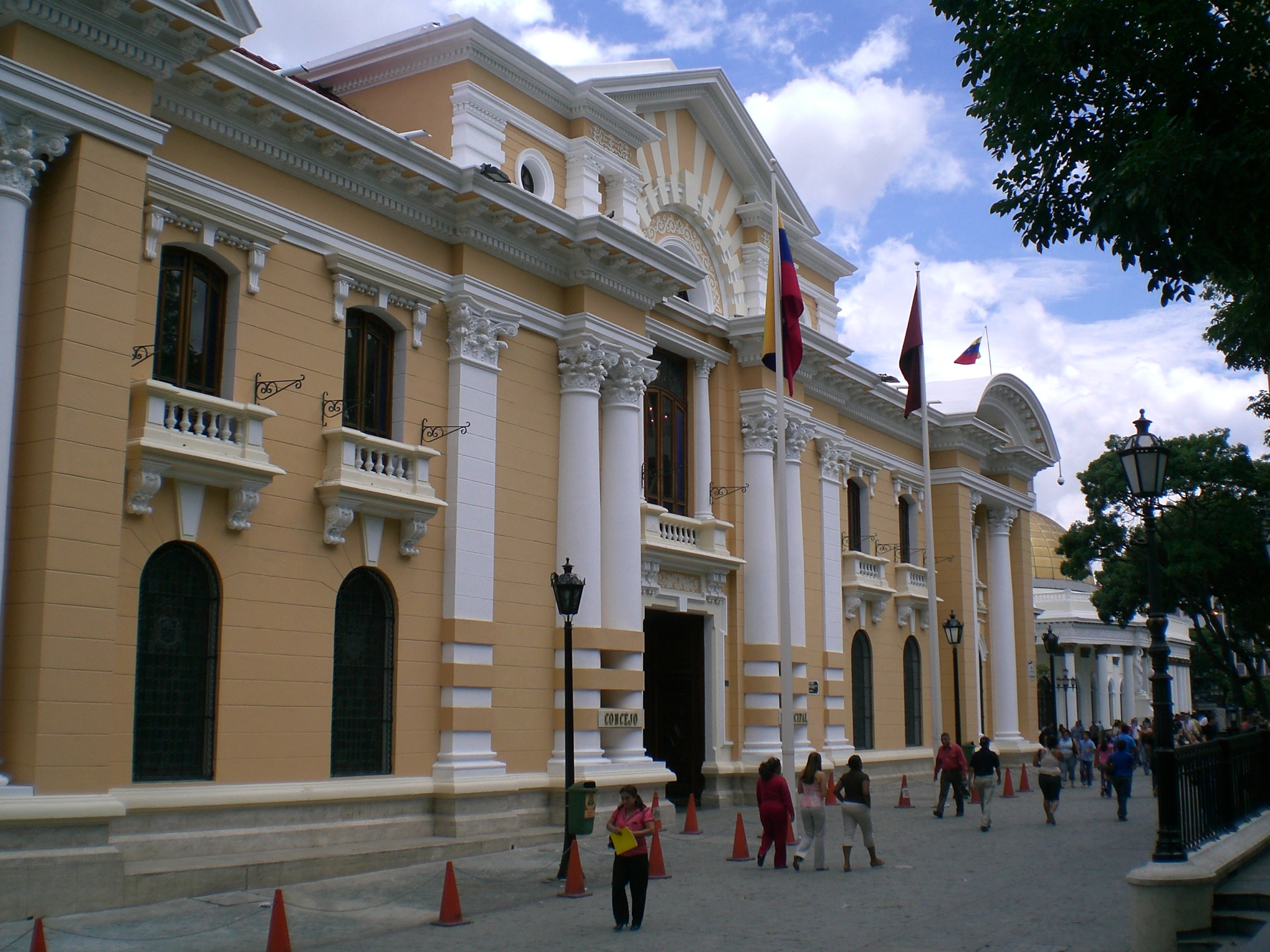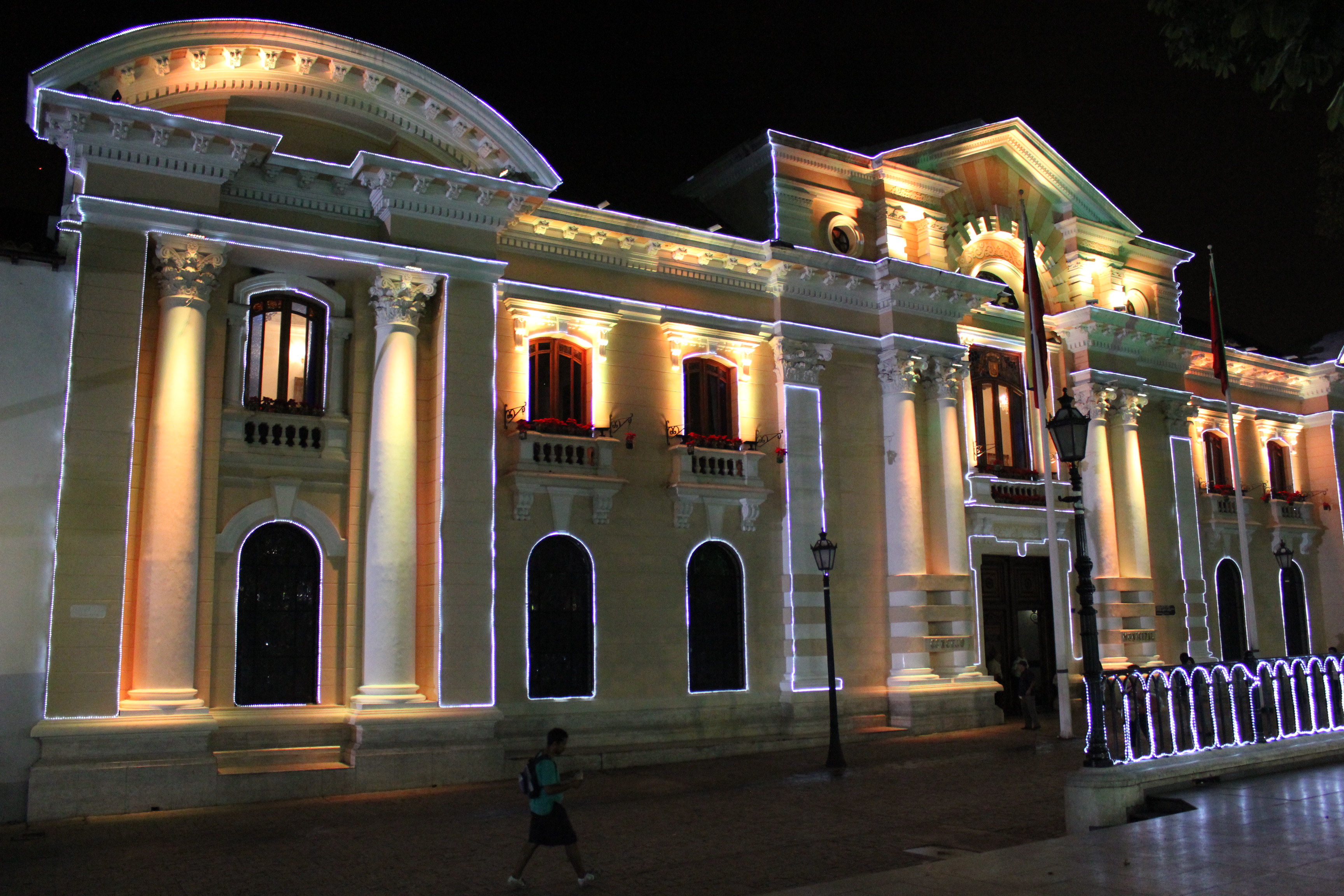Palacio Municipal de Caracas on:
[Wikipedia]
[Google]
[Amazon]
 The Palacio Municipal de Caracas, or Consejo Municipal de Caracas, is the
The Palacio Municipal de Caracas, or Consejo Municipal de Caracas, is the
 In 1673, Antonio Gonzáles de Acuña bought a number of buildings in the area around today's Plaza Mayor, adapting them to serve as a seminary. Known as the Colegio Seminario de Santa Rosa de Lima, it was the first seminary of the seventeenth century. It incorporated the features of the old chapel. Little by little, the seminary evolved as an institute of higher learning until in 1725 Juan José de Escalona y Calatayud, Bishop of Caracas, created the Real y Pontificia Universidad de Caracas which in 1810 became the Universidad de Los Andes, later renamed
In 1673, Antonio Gonzáles de Acuña bought a number of buildings in the area around today's Plaza Mayor, adapting them to serve as a seminary. Known as the Colegio Seminario de Santa Rosa de Lima, it was the first seminary of the seventeenth century. It incorporated the features of the old chapel. Little by little, the seminary evolved as an institute of higher learning until in 1725 Juan José de Escalona y Calatayud, Bishop of Caracas, created the Real y Pontificia Universidad de Caracas which in 1810 became the Universidad de Los Andes, later renamed

 Today's building is the result of the work undertaken by the Venezuelan architect
Today's building is the result of the work undertaken by the Venezuelan architect
 The Palacio Municipal de Caracas, or Consejo Municipal de Caracas, is the
The Palacio Municipal de Caracas, or Consejo Municipal de Caracas, is the city hall
In local government, a city hall, town hall, civic centre (in the UK or Australia), guildhall, or a municipal building (in the Philippines), is the chief administrative building of a city, town, or other municipality. It usually houses ...
of Caracas
Caracas (, ), officially Santiago de León de Caracas, abbreviated as CCS, is the capital and largest city of Venezuela, and the center of the Metropolitan Region of Caracas (or Greater Caracas). Caracas is located along the Guaire River in the ...
, Venezuela. It is located on the corner of Gradillas a Monjas opposite the Plaza Bolívar, occupying half of the plaza's southern section. The building dates from the seventeenth century but now bears the mark of Alejandro Chataing
Alejandro Chataing (February 24, 1873 – April 16, 1928) was an important Venezuelan architect. Chataing was known as the "great constructor of the regime of Cipriano Castro." He was a prolific architect who helped give Caracas a new face.
Intr ...
's Neoclassical additions in 1906. It was the focal point for the Constitutional Convention, and signing of the Declaration of Independence in the nineteenth century (declared on 5 July 1811 and hence known as the "cradle of independence"). The present building is the result of the work undertaken by the Venezuelan architect Alejandro Chataing
Alejandro Chataing (February 24, 1873 – April 16, 1928) was an important Venezuelan architect. Chataing was known as the "great constructor of the regime of Cipriano Castro." He was a prolific architect who helped give Caracas a new face.
Intr ...
in 1906. The west wing of the building, the Capilla de Santa Rosa de Lima (Santa Rosa chapel), the chapel where Venezuela's independence was declared in 1811, has been fully restored and furnished with authentic period pieces. The ground floor houses the Museo Caracas (Caracas Museum), which contains works by Venezuela's most celebrated painters and many other historic artifacts. It was declared a National Historic Landmark on 16 February 1979.
History
 In 1673, Antonio Gonzáles de Acuña bought a number of buildings in the area around today's Plaza Mayor, adapting them to serve as a seminary. Known as the Colegio Seminario de Santa Rosa de Lima, it was the first seminary of the seventeenth century. It incorporated the features of the old chapel. Little by little, the seminary evolved as an institute of higher learning until in 1725 Juan José de Escalona y Calatayud, Bishop of Caracas, created the Real y Pontificia Universidad de Caracas which in 1810 became the Universidad de Los Andes, later renamed
In 1673, Antonio Gonzáles de Acuña bought a number of buildings in the area around today's Plaza Mayor, adapting them to serve as a seminary. Known as the Colegio Seminario de Santa Rosa de Lima, it was the first seminary of the seventeenth century. It incorporated the features of the old chapel. Little by little, the seminary evolved as an institute of higher learning until in 1725 Juan José de Escalona y Calatayud, Bishop of Caracas, created the Real y Pontificia Universidad de Caracas which in 1810 became the Universidad de Los Andes, later renamed Universidad Central de Venezuela
The Central University of Venezuela (Spanish: ''Universidad Central de Venezuela''; UCV) is a public university of Venezuela located in Caracas. It is widely held to be the highest ranking institution in the country, and it also ranks 18th in L ...
by Bolívar.
In 1872, the building was renovated by President Antonio Guzmán Blanco as the Palacio de Justicia (Supreme Court of Venezuela). The western pavilion was added in 1881. Further renovations and adaptations from 1904 to 1906 were undertaken on the initiative of President Cipriano Castro
José Cipriano Castro Ruiz (12 October 1858 – 4 December 1924) was a high-ranking member of the Venezuelan military, politician and the president of Venezuela from 1899 to 1908. He was the first man from the Andes to rule the country, and was ...
by the architect Alejandro Chataing
Alejandro Chataing (February 24, 1873 – April 16, 1928) was an important Venezuelan architect. Chataing was known as the "great constructor of the regime of Cipriano Castro." He was a prolific architect who helped give Caracas a new face.
Intr ...
(1873–1928). In 1979, the building was listed as a national monument. The edifice was the focal point for the Constitutional Convention, and signing of the Declaration of Independence in the nineteenth century (declared on 5 July 1811 and hence known as the "cradle of independence"), the installation of the de la Academia de Matemáticas, and operation of the Cabildo de Caracas.
On Christmas Eve 1809, Bolivar made plans to storm city hall with other Creoles but was stopped by a military officer. In the west wing of the building, the Capilla de Santa Rosa de Lima (Santa Rosa chapel), the chapel where Venezuela's independence was declared in 1811, has been fully restored and furnished with authentic period pieces. Subsequent to the regional elections of 2008, followers of Lina Ron
Ninette Lina Ron Pereira (September 23, 1959 – March 5, 2011) was a Venezuelan political leader. She was the founder and president of the Venezuelan Popular Unity party, one of the parties which supported President Hugo Chávez. Ron ran one of t ...
, a Hugo Chávez
Hugo Rafael Chávez Frías (; 28 July 1954 – 5 March 2013) was a Venezuelan politician who was president of Venezuela from 1999 until his death in 2013, except for a brief period in 2002. Chávez was also leader of the Fifth Republ ...
supporter, took over city hall, graffitied the building's façade, and forced mayor Antonio Ledezma to another building, blocks away.
Architecture

Alejandro Chataing
Alejandro Chataing (February 24, 1873 – April 16, 1928) was an important Venezuelan architect. Chataing was known as the "great constructor of the regime of Cipriano Castro." He was a prolific architect who helped give Caracas a new face.
Intr ...
in 1906. It is located on the corner of Gradillas a Monjas opposite the Plaza Bolívar, and occupies half of the plaza's southern section. It is built in an eclectic Neoclassical style with three storeys along the main façade. The main entrance is flanked by double pillars in the composite order. It is crowned by a balcony decorated with composite pilasters and a triangular frontispiece. The east façade is also decorated with composite pillars designed to resemble those of the Roman Forum
The Roman Forum, also known by its Latin name Forum Romanum ( it, Foro Romano), is a rectangular forum (plaza) surrounded by the ruins of several important ancient government buildings at the center of the city of Rome. Citizens of the ancient ...
or similar works from antiquity. The large colonial building has an elegant patio in the interior and also houses the museum.
Museum
The Museo Caracas (also Museo Santana, or Museo Crillo) is located on the ground floor, though one of the rooms is reached via a narrow wooden stairway. The ground floor contains works by Venezuela's most celebrated painters and many other historic artifacts. Four of the Palacio's rooms are used for exhibiting some 3,000 artifacts of artistic or historic interest. In Room 2, there are paintings of two of Venezuela's historic presidents:Joaquín Crespo
Joaquín Sinforiano de Jesús Crespo Torres (; 22 August 1841 – 16 April 1898) was a Venezuelan military officer and politician. A member of the Great Liberal Party of Venezuela, he served as the president of Venezuela from 1884 to 1886 and aga ...
(1841–1898) by Arturo Michelena and, just to the left, José Tadeo Monagas
José Tadeo Monagas Burgos (28 October 1784 – 18 November 1868) was the president of Venezuela 1847–1851 and 1855–1858, and a hero of the Venezuelan War of Independence.
Career
Presidency
In 1846, to head off the challenge from the Liber ...
(1784–1868) by Martín Tovar y Tovar
Martín Tovar y Tovar (10 February 1827 – 17 December 1902) was a Venezuelan painter, best known for his portraits and historical scenes.
Biography
Tovar was born and died in Caracas. His father, Antonio María Tovar (1791–1860), was a fo ...
. Room 3 displays many of Santana's small carved figures representing Venezuelan celebrities from the early 20th century. Room 4 displays flags and banners including one from 1533 which belonged to the Spanish conquistador Francisco Pizarro. General Antonio José de Sucre presented it to Bolívar when he freed Venezuela from Spanish rule. Room 5 displays paintings by Venezuela's historic artists including Armando Reverón
Armando Reverón (May 10, 1889 – September 17, 1954) was a Venezuelan painter and sculptor, precursor of Arte Povera and considered one of the most important of the 20th century in Latin America. While his mental health deteriorated throughou ...
, Emilio Boggio
Emilio Boggio (21 May 18577 June 1920) was an Italian-Venezuelan pioneering impressionist painter. In 1864 he traveled to France and studied at the Lycée Michelet in Paris until 1870. In 1873, he returned to Caracas and dedicated himself to the ...
, Rafael Monasterios
Rafael may refer to:
* Rafael (given name) or Raphael, a name of Hebrew origin
* Rafael, California
* Rafael Advanced Defense Systems, Israeli manufacturer of weapons and military technology
* Hurricane Rafael, a 2012 hurricane
Fiction
* ''R ...
, Federico Brandt
Federico Brandt (17 May 1878 in Caracas – 25 July 1932 in Caracas) was a Venezuela
Venezuela (; ), officially the Bolivarian Republic of Venezuela ( es, link=no, República Bolivariana de Venezuela), is a country on the northern coast of ...
and Manuel Cabré
Manuel Cabré (January 25, 1890 – February 26, 1984) was a noted Spanish-Venezuelan landscape painter who is remembered as "the painter of El Ávila" ( es, link=no, El pintor de El Ávila).
Life and career
Cabré was born on January 25, 1890 ...
. Miniature paintings of the rural scenes drawn by Raul Santana are also on display. Bolivar is depicted in the heavens on a ceiling mural.
References
Bibliography
* * * * * *Further reading
* {{Caracas landmarks Buildings and structures in Caracas Palaces in Venezuela City and town halls in Venezuela Government buildings in Venezuela Government buildings completed in 1696 Tourist attractions in Caracas Museums in Caracas Monuments and memorials in Venezuela 1696 establishments in the Spanish Empire